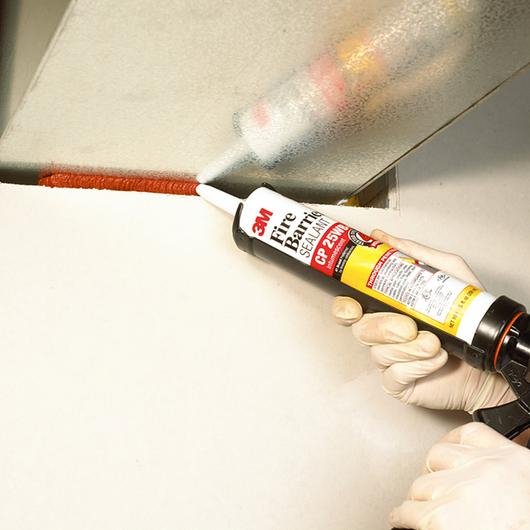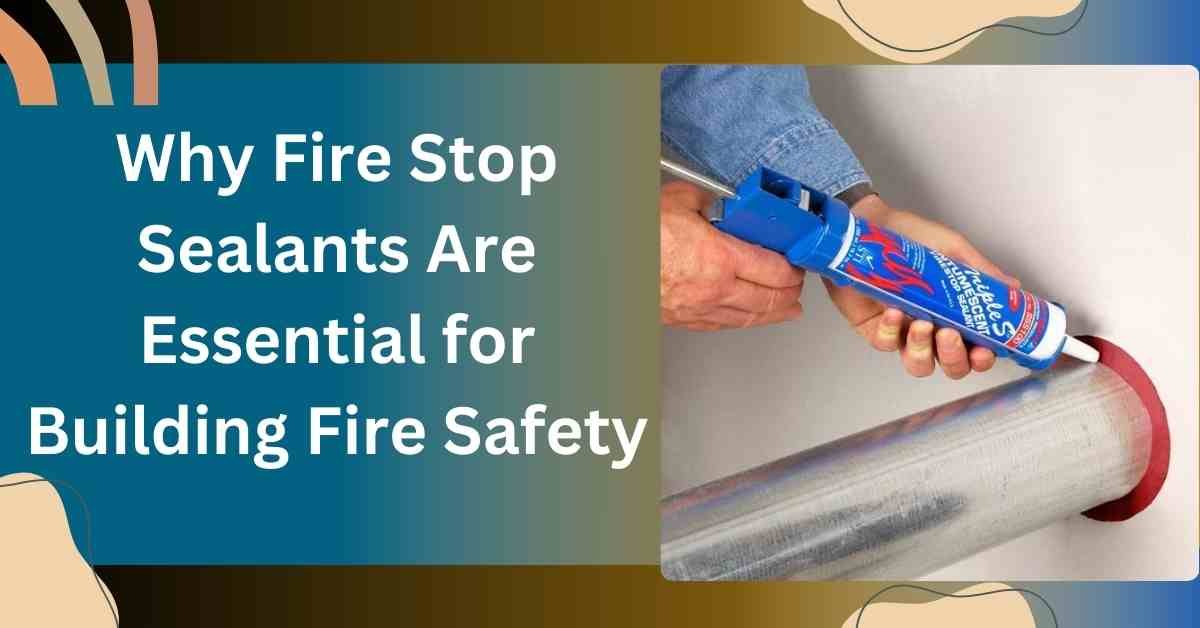When it comes to ensuring the safety of our homes, buildings, and workplaces, one thing is clear: fire safety must never be overlooked. One of the most effective ways to protect a building from fire damage and keep its occupants safe is by using fire stop sealants. But what exactly are fire stop sealants, and why are they so important? This blog will answer those questions and explain why every property owner should consider using fire stop sealant as part of their fire safety plan.
NOTE : Take action now to protect your home or building from the devastating effects of fire. Invest in high-quality fire stop sealants and ensure that your property is safe from fire and smoke. Whether you’re a homeowner or a commercial property owner, fire stop sealants are an essential part of any fire safety plan. Start shopping for the best fire stop sealant today and give your property the protection it deserves!

What Is Fire Stop Sealant?
Fire stop sealant is a special material used to seal openings, gaps, and joints in a building’s structure. These openings might be around electrical cables, pipes, ducts, or between walls, floors, and ceilings. Fire stop sealants are designed to prevent the spread of fire and smoke through these spaces. When exposed to heat, fire stop sealants expand to form a barrier that blocks fire and smoke from traveling, keeping the fire contained to the area where it started.
This simple yet highly effective material plays a critical role in protecting both the structure of a building and the safety of its occupants.
How Fire Stop Sealants Work
The key to understanding how fire stop sealants work lies in their ability to respond to heat. Most fire stop sealants are made from materials like silicone, intumescent compounds, or acrylics. These materials are designed to withstand high temperatures. When a fire breaks out, the sealant expands, filling the gap or crack it was applied to and creating a much more effective barrier against fire and smoke.
Intumescent fire stop sealants, for example, expand significantly when exposed to heat, creating a thicker, more impenetrable seal. This expansion helps to fill the gap even more, stopping the spread of flames and preventing smoke from infiltrating other rooms or floors in the building.
While the primary function of fire stop sealants is to block fire and smoke, they also offer a range of other benefits that make them a critical component of any fire safety plan.
Why Are Fire Stop Sealants Important for Fire Safety?
1. Prevent the Spread of Fire and Smoke
The most obvious and important reason to use fire stop sealants is their ability to prevent fire and smoke from spreading. During a fire, every second counts. As fire spreads through a building, it not only damages the structure but also puts people’s lives at risk. Fire can travel through cracks, gaps, and holes in walls, ceilings, and floors. If left unchecked, it can quickly spread throughout the building.
By filling these openings with fire stop sealant, you can stop the fire from spreading quickly, helping to contain it to a specific area. This extra time can make a huge difference, especially in giving people more time to evacuate and emergency services to arrive.
2. Containment of Toxic Smoke and Gases
Fire is not the only danger during a blaze; smoke and toxic gases are often just as deadly. Smoke can travel through hidden gaps in walls and ceilings, even in areas far away from the fire itself. These toxic fumes can incapacitate people, making evacuation difficult or impossible.
Fire stop sealants help prevent the movement of smoke, gases, and heat through the building. By sealing these gaps, fire stop sealants keep these harmful elements contained, reducing the risk of smoke inhalation and allowing more time for people to escape.
3. Compliance with Fire Safety Codes
In many places, building codes and fire safety regulations require the use of fire stop sealants in certain areas of buildings. These regulations are designed to ensure that buildings are as safe as possible in the event of a fire. Non-compliance with fire safety codes can result in fines, increased insurance premiums, or even the closure of the building in extreme cases.
Using fire stop sealants helps you comply with these important safety regulations. It ensures that your building is up to code and provides the protection required by law.
4. Cost-Effective Fire Protection
When it comes to fire safety, many people think that expensive fire suppression systems, sprinklers, or alarms are the only solutions. However, fire stop sealants offer a much more affordable way to enhance your building’s fire protection. These sealants are typically cost-effective, easy to apply, and can be installed in both new and existing structures.
Considering the high costs of fire damage and insurance claims, fire stop sealants are a small price to pay for the peace of mind they provide. They are a simple yet highly effective way to reduce the risk of widespread fire damage.
Types of Fire Stop Sealants
Not all fire stop sealants are the same. There are different types, each with its own advantages depending on the application. Let’s look at some of the most common types of fire stop sealants:
1. Silicone-Based Fire Stop Sealants
Silicone-based fire stop sealants are one of the most commonly used types. These sealants are highly flexible and durable, making them ideal for areas that experience movement or shifting, such as around windows, doors, or pipes. Silicone sealants are also resistant to weather, moisture, and aging, so they provide long-lasting protection.
2. Intumescent Fire Stop Sealants
Intumescent fire stop sealants are designed to expand when exposed to heat. This expansion allows them to create a thick, fire-resistant barrier that fills gaps and cracks more effectively. Intumescent sealants are often used in high-risk areas such as around electrical cables, ducts, and pipes. They are ideal for areas where fire could spread quickly.
3. Acrylic Fire Stop Sealants
Acrylic-based fire stop sealants are another option. While not as heat-resistant as silicone or intumescent sealants, acrylic sealants are a great choice for smaller, less risky areas that still require fire protection. Acrylic sealants are affordable and easy to apply, making them a good choice for DIY homeowners or for less critical applications.
4. Fire Stop Putty
Fire stop putty is typically used for sealing around cables, pipes, and other penetrations. The putty expands when heated, providing a tight seal and preventing fire from traveling through gaps in the building’s structure. Fire stop putty is often used in combination with other sealant types for a more complete solution.
5. Fire Stop Caulk
Fire stop caulk is similar to traditional caulk but designed for fire resistance. It can be used in various applications, including sealing gaps around windows, doors, and ducts. Fire stop caulk is easy to apply, dries quickly, and provides a flexible barrier against fire and smoke.
Choosing the Right Fire Stop Sealant for Your Building
When selecting a fire stop sealant for your building, there are several factors to consider:
1. Location and Application
Consider where the fire stop sealant will be applied. Is it for interior or exterior use? Will it be exposed to the elements, or will it be used in a controlled environment? The type of sealant you choose should match the specific conditions of the area you’re sealing.
2. Fire Resistance Rating
Different fire stop sealants have different fire resistance ratings. Be sure to choose a sealant that is rated for the temperature and fire conditions in your area. Fire resistance ratings can vary from 1 hour to 4 hours or more, depending on the material and application.
3. Flexibility and Durability
Some areas of your building may experience movement, such as around windows and doors. In these cases, you’ll need a more flexible sealant that can expand and contract without losing its effectiveness. Silicone-based sealants are often the best choice for these areas.
4. Ease of Application
If you’re doing the installation yourself, choose a fire stop sealant that is easy to apply. Look for products that come with clear instructions and easy-to-use applicators. Some sealants are designed for quick and easy application, while others may require more specialized tools.
Conclusion
Fire stop sealants are one of the most important tools in ensuring fire safety for any building. They are cost-effective, easy to apply, and highly effective at preventing the spread of fire and smoke. Whether you are building a new home, renovating an existing property, or just looking to improve the fire safety of your space, fire stop sealants should be at the top of your list. By choosing the right fire stop sealant for your needs, you can help protect your property and loved ones from the devastating effects of fire. Don’t wait until it’s too late – start improving your fire safety today.
For more insightful articles related to this topic, feel free to visit articleconsult
